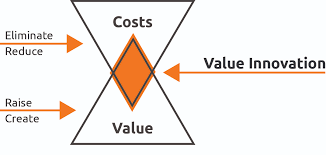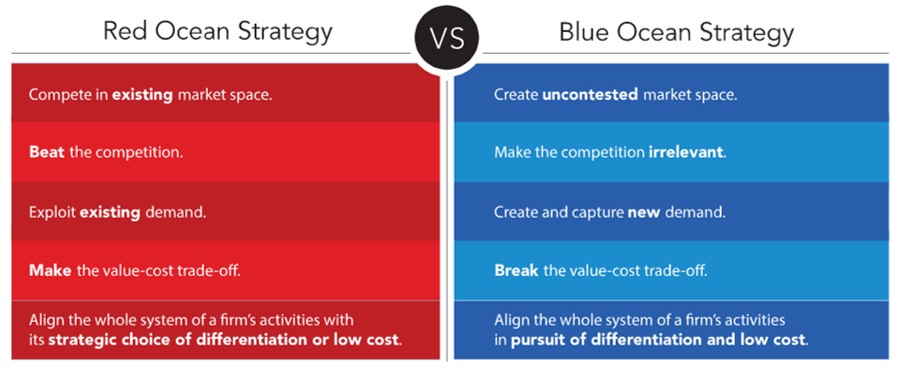The Blue ocean strategy was developed by W. Chan Kim and Renée Mauborgne in their research in 2005. By analyzing 150 business strategies during over 100 years in 30 different industrial sectors, Kim and Mauborgne (2005) propose that firms succeed not because of fighting with their rivals, but because they have created “blue ocean” in the market space. This method makes a leap in value for firms, customers, and employees by creating new needs with almost no competition in these markets.
1. Blue and red ocean metaphors
Blue and red ocean metaphors are intended to describe the entire market system. The red ocean represents all existing industries or known market space. In the red ocean, all boundaries are defined and accepted, and rules of competition have been established. Firms in this environment must make effort to outperform their rivals for gaining market shares in different ways. As the market gets larger in quantity, the potential for profits and product development tend to decrease face to competition. Products and services will quickly become popular goods or niche markets; fierce competition will increase to the destructive level in the market; so, these industries are called the red oceans.
In contrast, the blue ocean includes industries that do not yet exist. They are market spaces that are not known and not yet destroyed by competition. In blue oceans, market demand is created by the firm rather than won. There are many opportunities and potentials for rapid growth with high profit rates. In the blue ocean, the competition is minimum or do not exist, because the competitive rules are not established. The blue ocean is a metaphor describing the immense potential of unexploited market spaces. Some blue oceans are created outside the existing industry boundaries, but most are created from the red oceans by expanding the current industry boundaries.
Firms look for blue oceans for some key reasons. Firstly, the continuous and strong development of technology allows them to produce higher quality products and services with diverse models and categories. Secondly, firms do not want to come into red oceans, that are considered as the battlefield of life and death while the profitability and growth are low. Thirdly, blue oceans attract firms both in profits and high growth.
2. The concept of Value innovation
The key factor that allows firms to create blue oceans is the concept of “Value Innovation”. Value innovation is the result of an effort to pursue a differentiation strategy and low-cost strategy; thereby creating value for customers, firms themselves, and employees due to the profits gained from the new market space. The purpose of value innovation is not competition but for making competition no longer by changing the strategic environment.
It should be emphasized that, in the blue ocean strategy, value innovation includes both value improvement and innovation. By focusing only on value, that is the correlation of low price and quality, firms can make profit in short term, but cannot achieve a sustainable competition in long term. On the other hand, if innovation does not come with value, it will not be enough to convince customers to buy and consume products and services of the firms. Value innovation is established only when firms successfully combine innovation and usefulness, price, and cost. Otherwise, technology is merely a technology of “beauty”.
Figure 1: Value innovation in Blue ocean strategy

Source: Kim and Mauborgne (2005)
Creating a blue ocean means reducing costs for firms while increasing customer value; thereby achieving the goal of improving value for both firms and their customers. Product market value is a combination of price and customer utility; similarly, firm value is a combination of selling price and cost structure. Therefore, the value innovation is achieved only when all three factors of utility, price and cost are properly combined. These are the factors that make up a sustainable blue ocean strategy (Kim and Mauborgne, 2005).
Red ocean strategy is based on competition, and standardized and immutable conditions. Firms in red oceans compete each other on the basis of fitness with these conditions and the “best strategy” common rule. Strategic orientations can be either differentiation or low cost. This is a “structuralism view” or “environmental determinism”. In contrast, the value innovation relies on the belief that market boundaries and structures are not standardized and can be created by the actions and beliefs of the competitors. The strategic goal is to create new standards for “best strategy”. This view is called the “deconstructionists view”.
Table 1: Red Ocean Versus Blue Ocean Strategy

Source: Kim and Mauborgne (2005)

10 Sep 2019